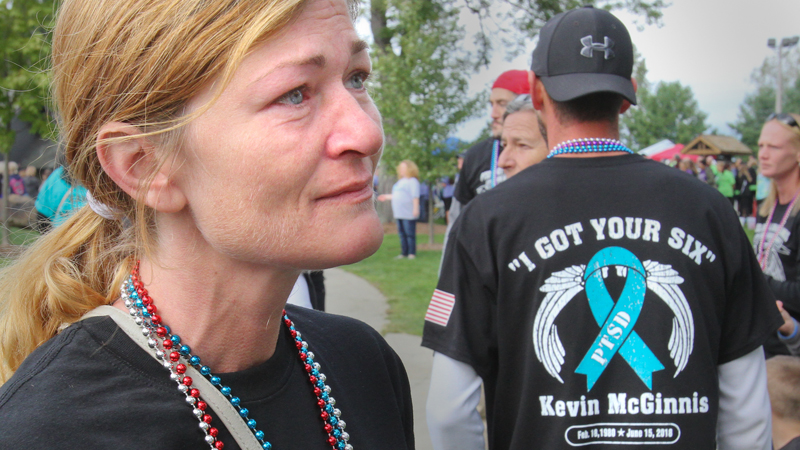Annual Out of the Darkness walk shines light on suicide

By Sean Barron
YOUNGSTOWN
For much of his young life, Nathan Montgomery had an outgoing, affable personality – the type of person who loved skateboarding and taking his young nephews fishing and bowling, to movies and to Cleveland Indians games.
In early 2017, however, the landscape of his life looked ominous.
“He came to me and said, ‘Mom, I’m kind of depressed,’” Denise Reynolds recalled about her late son.
Nathan killed himself Jan. 12. He was 26.
Reynolds of Cortland shared her son’s story during Saturday’s annual Out of the Darkness Community Walk that began and ended in Mill Creek MetroParks’ James L. Wick Recreation Area as part of September’s National Suicide Prevention Awareness Month.
Nearly 3,000 people, including an estimated 1,100 who registered online, took part individually or on 125 teams in the 3-mile walk through the park. The two-hour event also was to raise awareness of suicide and money for prevention efforts that include counseling, education and programs for veterans, noted Cindy Orslene, an event organizer who lost her 25-year-old son, Terry Rainey, about five years ago to suicide.
“This [walk] is therapy for a lot of people,” said Orslene, who added that the event’s $35,000 goal was exceeded.
Support of loved ones who took their lives was everywhere, as walkers wore T-shirts that announced the names of their teams, including “Donny’s Soldiers,” Walk 4 Terry,” “Larry’s Lineup” and “Team Travis.”
Reynolds and about 35 family members and friends made up “Team Nate,” in Montgomery’s memory and honor. Also walking on his behalf were two people to whom he had sold cars while employed at Greenwood Chevrolet in Cortland, including one who became Montgomery’s boss at his next job, Reynolds continued.
She also recalled that the death of Montgomery’s grandfather was a catalyst that led to severe depression and resulted in his spending several weeks in Trumbull Memorial Hospital in Warren and another facility.
“We did our best to help him out of his depression,” she said.
Reynolds’ sister, Jennifer Henderson, also said she tried her best to help him, but still experiences guilt, a common feeling among those who lose a loved one to suicide. Henderson added she wishes she had reached out to her brother more often, but sometimes was unsure of what to say to him.
“He was outgoing and charismatic. He could walk into a room of 100 people and make 100 friends,” Jessica Patrick of Girard recalled about her fiance, Kevin McGinnis, who ended his life June 15 at age 38.
Patrick tearfully said that after an 11-year courtship, she and McGinnis planned to marry next June.
She and at least 40 other family members and friends made up a team called “I Got Your Six,” a military saying often expressed by McGinnis, who had served three years in the Army that included tours of duty in Afghanistan and as a medic.
McGinnis, who also drove Amish laborers to their job sites, suffered from depression and post-traumatic stress disorder. His suicide was “soul-crushing” to her and others who cared about him, Patrick said.
“Don’t be afraid to speak up” if you’re contemplating suicide, she advised. “If you need help, say so. Reach out to somebody – anybody.”
Before the walk, several people offered emotional personal testimonials, including Ryan Halicki, a broadcaster with WYTV Channel 33, who lost his nephew, Teegan Kamzelski, 24, in May 2017 to suicide.
People who lose loved ones in this manner generally experience grief differently from those whose loved ones die from accidents or natural causes, for example. A major difference is guilt, because people often lament that they could have or should have done more to help someone who died from suicide, he noted.
“A loss to an accident is out of your control, but with suicide ... there are so many questions you’ll never have an answer to, but with time, it gets easier. The guilt fades over time,” Halicki explained.
Also on hand were volunteers with Sit Means Sit Dog Training, who brought about six therapy dogs to offer emotional support and comfort.
“They can tell when someone needs them,” said Jessie Knez, one of the volunteers.
The walk also included the release of a few dozen white doves, birds that symbolize love and peace to many people.
 43
43
